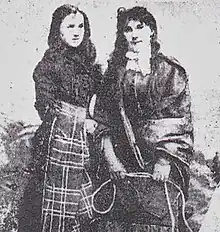Jessie Ace and Margaret Wright
Jessie Ace (1860–1936) and Margaret Wright (née Ace; 1854–1933) are known for their rescue of crewmen from the Mumbles lifeboat, which had gone to assist a wrecked German barque during an 1883 storm at Mumbles Head, Wales.

Lifeboat rescue
Ace and Wright were daughters of the Mumbles Lighthouse keeper Abraham Ace.[1]
On 27 January 1883, an 885-ton German barque named Admiral Prinz Adalbert of Danzig was caught in a storm in Mumbles Head and wrecked just below the lighthouse.[2] The Mumbles lifeboat came to rescue the crew.[3] When the Mumbles lifeboat, a wooden sailboat named the Wolverhampton, got into trouble Wright and Ace waded into the surf to rescue the lifeboat crew. They tied their shawls together to use as a rope and rescued two of the lifeboat crewmen who had fallen overboard.[4]
It is reported that Wright cried: "I will lose my life than let these men drown" as she waded into the icy waters.[5] While some claimed the story was apocryphal, their father confirmed the actions of his daughters, alongside those of Gunner Edward Hutchings, in rescuing two crew members from the ship during the inquest into the disaster.[2][6] Four of the Wolverhampton crew died that night, leaving four widows and fourteen orphaned children.[7] The same storm also wrecked two other ships (Agnes Jack and James Grey) on the Gower Peninsula, claiming 44 lives.[8]
Recognition
While the Royal National Lifeboat Institution awarded a silver medal and £50 to the coxswain who had aided the women in the rescue, and issued a commendation on vellum to Hutchings, it did not officially recognize the sisters' role.[4]
The sisters did receive gold brooches from Augusta of Saxe-Weimar-Eisenach, the Empress of Germany, for caring for the barque's crew.[4] The women gained international fame when they were featured on the front page illustration of The Graphic in February 1883.[9][10]
Legacy
Clement Scott wrote a poem, The Women of Mumbles Head, in tribute to their heroic actions.[11]
_Blue_Plaque_to_'The_Women_of_Mumbles_Head'.jpg.webp)
In 2016, a blue plaque was erected by Mumbles Pier to commemorate their bravery.[12][4]
Later years
In 1885, Jessie Ace married John Dunstan at St. Mary's, Swansea; the two emigrated to Australia in 1889. The couple divorced in 1901.[13] She died in 1936 in New South Wales, where she was buried.[14][15]
References
- Carol Powell. "Keepers of the Light at Mumbles Lighthouse". A History of Mumbles. Archived from the original on 13 October 2020. Retrieved 7 March 2018.
- "Swansea – The Ace Sisters Blue Plaque". swansea.gov.uk. Archived from the original on 8 March 2018. Retrieved 7 March 2018.
- Turner, Robin (17 October 2013). "Swansea's rich maritime history welcomes the new Mumbles Lifeboat". walesonline. Retrieved 7 March 2018.
- Turner, Robin (11 December 2015). "Heroic Swansea sisters set to be honoured for saving lifeboat crew". walesonline. Retrieved 7 March 2018.
- "The Ace Sisters". Lore Enforcement. 1 November 2017. Retrieved 7 March 2018.
- "The Mumbles Lifeboat Disaster". South Wales Daily News. 31 January 1883. Retrieved 16 March 2018.
- Elphick, Stella. "Mumbles Lifeboat". www.explore-gower.co.uk. Retrieved 16 March 2018.
- "Disaster at Mumbles". Wales. 7 January 2014. Retrieved 16 March 2018.
- "The gallant rescue by mrs Wright and miss Jessie Ace of men of the..." Getty Images. Retrieved 7 March 2018.
- "Mumbles Lifeboat Disaster". The Graphic. 24 February 1883.
- "The story and poem of The women of Mumbles Head – A History of Mumbles". sites.google.com. Retrieved 7 March 2018.
- "Blue Plaques of Swansea". The Bay Magazine Swansea. 29 June 2017. Retrieved 7 March 2018.
- Divorce Court: Dunstan v. Dunstan, The Sydney Morning Herald, (Wednesday, 20 March 1901), p.10; Divorce Court: Dunstan v. Dunstan, The Sydney Morning Herald, (Wednesday, 27 March 1901), p.5; Divorce Court: Decrees Absolute, The Sydney Morning Herald, (Friday, 21 June 1901), p.3.
- "Swansea Family History – Reflections 2". www.swanseafamilyhistory.co.uk. Archived from the original on 8 March 2018. Retrieved 7 March 2018.
- Given the evidence within the service record of the individual who might have been her son, Oscar Reginald Dunstan (1897-1936) (see letter at World War One Service Record: Oscar Reginald Kollosche (14613), National Archives of Australia, at p.19), she may have gone under the name of "Kollosche".